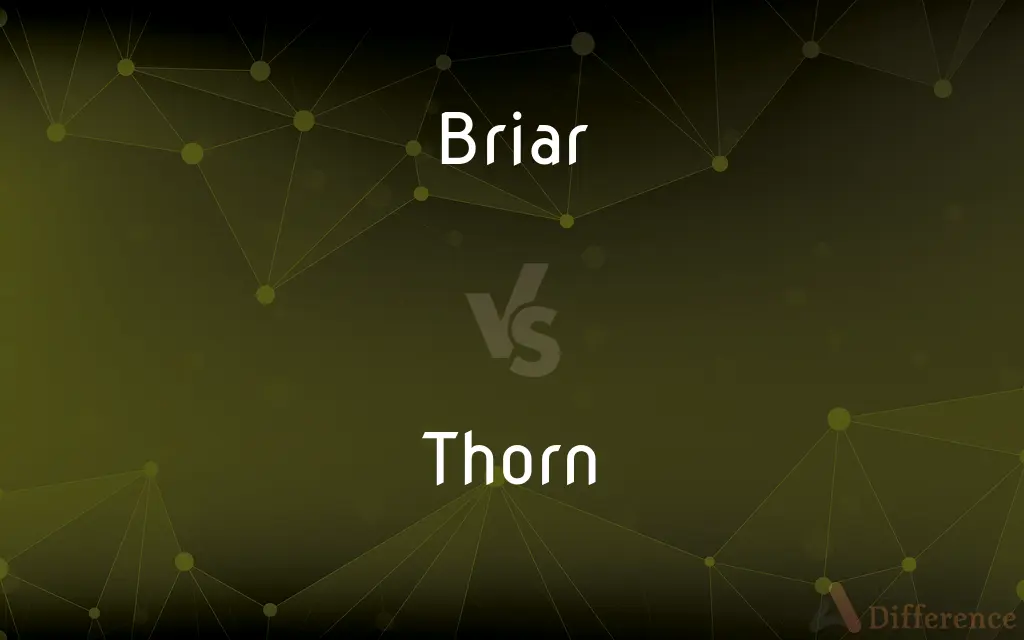Briar vs. Thorn — What's the Difference?
By Tayyaba Rehman & Urooj Arif — Updated on March 8, 2024
Briars are any of various thorny plants or shrubs, while thorns are sharp, stiff points on plants, serving as a defense mechanism.

Difference Between Briar and Thorn
Table of Contents
ADVERTISEMENT
Key Differences
Briars and thorns are both associated with plants, but their meanings and contexts vary. Briars refer specifically to certain thorny plants or shrubs, often found in wild or natural settings. On the other hand, thorns are sharp, stiff outgrowths found on various parts of plants, including stems and branches.
Briars are often mentioned in literature and folklore, symbolizing wild, untamed nature and sometimes protection or difficulty. Whereas thorns, by contrast, are commonly used to represent pain, danger, or the idea of protection in a more direct sense.
Culturally, briars may be associated with rustic or countryside aesthetics, reflecting an appreciation for the natural, rugged beauty of such plants, despite their thorns. While thorns are universally recognized for their protective role in nature, serving as a poignant reminder of the defenses plants have evolved to survive in their environments.
Comparison Chart
Definition
A thorny plant or shrub, often wild.
A sharp, stiff point on a plant.
Function
Part of the plant's structure; can be protective.
Serves as a defense mechanism.
ADVERTISEMENT
Examples
Wild rose bushes, blackberry bushes.
Found on roses, cacti, and other plants.
Symbolism
Wild nature, protection, difficulty.
Pain, danger, protection.
Usage in Language
More specific to certain plants.
Broadly used for sharp plant defenses.
Compare with Definitions
Briar
A thorny shrub or bush, often found in wild areas.
The dense briar patch provided excellent cover for small animals.
Thorn
A stiff, sharp point on a plant.
She pricked her finger on a rose's thorn.
Briar
Used in the making of certain goods, like briar pipes.
His favorite smoking pipe was carved from briar wood.
Thorn
Part of the plant that can cause injury.
Removing the thorns required gloves to avoid injury.
Briar
Any plant with a tough, thorny stem or branches.
The briar roses added a wild beauty to the garden.
Thorn
Found on various plants, including roses and cacti.
The cactus displayed its thorns proudly against the desert sun.
Briar
A plant known for its dense, thorny nature.
Walking through the briar left us with scratched arms and legs.
Thorn
Serving as a defense against herbivores.
The thorn's sharpness keeps grazing animals at bay.
Briar
Symbolic of natural protection or obstacles.
He considered the briar's thorns a metaphor for life's challenges.
Thorn
A symbol of pain or annoyance.
His constant complaining became a thorn in her side.
Briar
Any of a number of prickly scrambling shrubs, especially a wild rose.
Thorn
A modified branch in the form of a sharp woody structure.
Briar
A tobacco pipe made from woody nodules borne at ground level by a large woody plant of the heather family.
Thorn
Any of various other sharp protuberances, such as a spine.
Briar
The tree heath, which bears the nodules from which briar pipes are made.
Thorn
Any of various shrubs, trees, or woody plants bearing such sharp structures.
Briar
Any of several prickly plants, such as certain rosebushes or the greenbrier.
Thorn
Any of various sharp protuberances on an animal.
Briar
A Mediterranean shrub or small tree (Erica arborea) in the heath family, whose woody roots are used to make tobacco pipes. Also called tree heath.
Thorn
One that causes sharp pain, irritation, or discomfort
He is a thorn in my side.
Briar
A pipe made from the root of this plant or from a similar wood.
Thorn
The runic letter þ, used in Old English, Middle English, and Old Norse manuscripts to represent both the voiceless sound (th) of Modern English thin and the voiced sound (th) of Modern English this, and in modern Icelandic orthography to represent the voiceless sound (th).
Briar
Variant of brier1.
Thorn
(botany) A sharp protective spine of a plant.
Briar
Any of many plants with thorny stems growing in dense clusters, such as many in the Rosa, Rubus, and Smilax genera.
Thorn
Any shrub or small tree that bears thorns, especially a hawthorn.
The white thorn
The cockspur thorn
Briar
(figurative) Anything sharp or unpleasant to the feelings.
Thorn
(figurative) That which pricks or annoys; anything troublesome.
Briar
The white heath (Erica arborea), a thorny Mediterranean shrub.
Thorn
A letter of Latin script (capital: Þ, small: þ), borrowed from the futhark; today used only in Icelandic to represent the voiceless dental fricative, but originally used in several early Germanic scripts, including Old English where it represented the dental fricatives that are today written th (Old English did not have phonemic voicing distinctions for fricatives).
Briar
A pipe for smoking, made from the roots of that shrub.
Thorn
To pierce with, or as if with, a thorn (sharp pointed object).
Briar
Same as Brier.
Thorn
A hard and sharp-pointed projection from a woody stem; usually, a branch so transformed; a spine.
Briar
Eurasian rose with prickly stems and fragrant leaves and bright pink flowers followed by scarlet hips
Thorn
Any shrub or small tree which bears thorns; especially, any species of the genus Cratægus, as the hawthorn, whitethorn, cockspur thorn.
Briar
A very prickly woody vine of the eastern United States growing in tangled masses having tough round stems with shiny leathery leaves and small greenish flowers followed by clusters of inedible shiny black berries
Thorn
Fig.: That which pricks or annoys as a thorn; anything troublesome; trouble; care.
There was given to me a thorn in the flesh, the messenger of Satan to buffet me.
The guilt of empire, all its thorns and cares,Be only mine.
Briar
Evergreen treelike Mediterranean shrub having fragrant white flowers in large terminal panicles and hard woody roots used to make tobacco pipes
Thorn
The name of the Anglo-Saxon letter , capital form . It was used to represent both of the sounds of English th, as in thin, then. So called because it was the initial letter of thorn, a spine.
Briar
A pipe made from the root (briarroot) of the tree heath
Thorn
To prick, as with a thorn.
I am the only rose of all the stockThat never thorn'd him.
Thorn
Something that causes irritation and annoyance;
He's a thorn in my flesh
Thorn
A sharp-pointed tip on a stem or leaf
Thorn
A Germanic character of runic origin
Common Curiosities
What are briars?
Briars refer to any of various thorny plants or shrubs, often characterized by their dense, prickly stems or branches.
Can all thorns be considered briars?
Not all thorns are considered briars, as thorns can be found on a wide variety of plants, not just those classified as briars.
Are briars always harmful?
While briars can cause scratches or discomfort, they are not always harmful and can provide habitat and protection for wildlife.
Can briars be used for any practical purposes?
Yes, some briars, like those from briar root, are used to make items such as pipes due to their durable and heat-resistant properties.
What is a thorn?
A thorn is a sharp, stiff outgrowth on a plant, serving as a defense mechanism against predators.
Do thorns have any uses beyond defense?
While primarily for defense, thorns can also contribute to a plant's aesthetic appeal and are sometimes used symbolically in art and literature.
How can you safely remove a thorn?
To safely remove a thorn, it's advised to use tweezers, disinfect the area, and ensure the entire thorn is removed to prevent infection.
What distinguishes a thorn from a spine or a prickle?
Thorns are derived from shoots or branches, spines from leaves, and prickles are extensions of the outer layer of the plant, each with different structures and origins.
What role do briars play in ecosystems?
Briars can provide important habitat and food sources for wildlife, contributing to the biodiversity of their ecosystems.
How do plants benefit from having thorns?
Thorns protect plants from herbivores and potential damage by deterring animals from eating them.
Is it common for briars to flower?
Yes, many briars, such as rose bushes, produce flowers, which can add to their aesthetic value despite their thorns.
How do animals interact with thorny plants?
Some animals avoid thorny plants due to the risk of injury, while others, like birds, may use them as protective nesting sites.
Can thorns be found on trees as well as shrubs?
Yes, thorns can be found on a variety of plants, including both shrubs and trees.
Why are briars often associated with difficulty or challenges?
The dense, thorny nature of briars can make them difficult to navigate, leading to their metaphorical association with life's challenges.
Are there any cultural or symbolic meanings attached to thorns?
Thorns are often seen as symbols of protection, pain, and suffering, featuring prominently in various cultural and religious contexts.
Share Your Discovery

Previous Comparison
Wireless vs. Cordless
Next Comparison
Symbolize vs. SymboliseAuthor Spotlight
Written by
Tayyaba RehmanTayyaba Rehman is a distinguished writer, currently serving as a primary contributor to askdifference.com. As a researcher in semantics and etymology, Tayyaba's passion for the complexity of languages and their distinctions has found a perfect home on the platform. Tayyaba delves into the intricacies of language, distinguishing between commonly confused words and phrases, thereby providing clarity for readers worldwide.
Co-written by
Urooj ArifUrooj is a skilled content writer at Ask Difference, known for her exceptional ability to simplify complex topics into engaging and informative content. With a passion for research and a flair for clear, concise writing, she consistently delivers articles that resonate with our diverse audience.















































